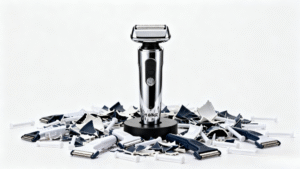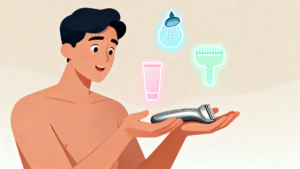For the last decade, “sustainability” in the consumer electronics industry often meant one thing: the packaging. A recycled cardboard box, a smaller footprint—these were the badges of environmental honor. But a quiet, profound revolution is now underway. The box is no longer the hero of the sustainability story; the product itself is.
The most forward-thinking brands are now pioneering the use of sustainable materials for electronics not for the part the customer throws away, but for the durable product housings they hold in their hands every day. This article will explore this critical trend, diving into the two main categories of innovation—advanced recycled materials and bioplastics. We will analyze their readiness for the mainstream, the manufacturing challenges they present, and their immense potential to redefine the personal care industry.
The “Why”: Drivers of the Shift to Sustainable Housings
This move isn’t just a marketing gimmick; it’s a strategic response to powerful market forces. Understanding these drivers is key to understanding the trend’s longevity.
- Consumer Demand: Today’s consumers, particularly in the US and European markets, are increasingly making purchasing decisions based on a brand’s environmental credentials. A product made from sustainable materials has a powerful, built-in story that resonates deeply.
- Corporate Responsibility (ESG): Brands are under intense pressure from investors, employees, and stakeholders to improve their Environmental, Social, and Governance (ESG) scores. Reducing reliance on virgin, fossil-fuel-based plastics is a highly visible and impactful key performance indicator.
- Regulatory Pressure: Governments worldwide are enacting stricter regulations around e-waste, single-use plastics, and the circular economy. Brands are proactively innovating with materials to get ahead of future compliance requirements.
- Product Differentiation Strategy: In a crowded market, a body groomer made from “recycled ocean-bound plastic” has a unique and marketable story. A commitment to sustainability is no longer just good ethics; it’s a powerful competitive advantage.

The Contenders Part 1: Advanced Recycled Materials
This is the most mature and rapidly growing category of sustainable materials for electronics. This isn’t about melting down old milk jugs in a simple process; it involves sophisticated supply chains and polymer science to create high-quality, reliable resins.
- PCR (Post-Consumer Resins): This is the industry standard for recycled plastics. PCR resins are derived from plastic waste that has been used by consumers and then collected and reprocessed.
- Pros: It directly diverts waste from landfills, has a significantly lower carbon footprint than virgin plastic, and the technology is well-established.
- Cons: The supply chain can be complex, and there can be minor inconsistencies in color or finish between batches, requiring a robust QC process.
- Recycled Ocean-Bound Plastics: This is a sub-category of PCR with a powerful marketing story. It involves collecting plastic waste from communities within 50km of a coastline, preventing it from ever entering the ocean. While logistically complex and more costly, it offers an unparalleled narrative of positive environmental impact.
The B2B Insight: The primary challenge in using recycled materials in manufacturing is vetting the supply chain for recycled plastics. Brands must partner with manufacturers who can provide certification and guarantee the source, consistency, and performance specifications of these resins.

The Contenders Part 2: Bioplastics
This is the next frontier. Bioplastics are plastics derived from renewable biomass sources like corn starch or sugarcane, rather than petroleum. They represent a major step towards decoupling manufacturing from fossil fuels.
| Bioplastic Type | Common Source | Key Properties | Best Application for Groomers |
| PLA (Polylactic Acid) | Corn starch, sugarcane | Rigid, brittle, good surface finish, but has low heat and impact resistance. | Internal structural components, decorative elements not subject to stress, premium packaging inserts. |
| PHA (Polyhydroxyalkanoates) | Made by microorganisms | More flexible and durable than PLA, better heat/water resistance. Biodegradable in soil/marine environments. | Potentially suitable for non-critical parts of product housings, soft-touch grips, or flexible elements. |
The B2B Insight: The biggest hurdle for using bioplastics in consumer products like groomers is long-term durability. While their eco-friendly origins are a huge plus, these materials must still withstand years of use, exposure to moisture, and potential drops. Any brand exploring bioplastics for product housings must invest heavily in long-term durability testing to ensure the product meets consumer expectations for lifespan and reliability.

The Manufacturing Reality: Challenges and Solutions
Integrating these new materials is not a simple “drop-in” replacement for ABS or polycarbonate plastic. It requires a new approach to eco-friendly product design and manufacturing.
- The Challenge of Material Properties: Recycled and bioplastics have different melt flows, shrink rates, and temperature tolerances than virgin plastics. Using them in a mold designed for ABS will likely lead to defects.
- The Solution: Brands must partner with manufacturers who have proven, specific experience with these materials. Before committing, ask your supplier for case studies of durable electronic housings they have successfully produced using PCR or bioplastics.
- The Challenge of Aesthetics & CMF: Recycled plastics can have minor imperfections, such as tiny black specks or slight color variations.
- The Solution: Embrace it. A modern Sustainable CMF (Color, Material, Finish) strategy turns this into a feature. Brands can market these unique marks as “proof of authenticity,” showing that each unit is unique and genuinely made from recycled content.
- The Challenge of Cost: Currently, high-grade recycled resins and most bioplastics are more expensive than their virgin petroleum-based counterparts.
- The Solution: The higher cost must be a strategic decision. It needs to be offset by the brand value and marketing story that the material provides. This must be a core part of your brand’s identity, targeting consumers who are willing to pay a premium for a genuinely sustainable product.
Conclusion: From a Trend to a Necessity
The use of sustainable materials for electronics is rapidly evolving from a niche trend to a core business imperative. While packaging was the first frontier, the true innovation is now happening in the product itself. Advanced recycled materials like PCR are ready for primetime and offer a proven, impactful way to reduce a product’s carbon footprint. Bioplastics show incredible future promise, but still require further development to meet the long-term durability demands of electronic housings.
For brands and manufacturers, the message for 2026 and beyond is clear: the future of product design is circular and sustainable. The companies that master the science, supply chain, and storytelling of these new materials will not only win environmentally-conscious consumers—they





